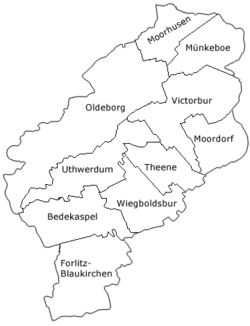Moordorf, Lower Saxony
East Frisia stubsTowns and villages in East FrisiaVillages in Lower SaxonyWeser-Ems region geography stubs
Moordorf is a village in the German state of Lower Saxony. It is in the municipality of Südbrookmerland in the district of Aurich. Moordorf's most notable feature is the Moormuseum Moordorf, showing what life was like in the small huts on the East Frisian moors.
Excerpt from the Wikipedia article Moordorf, Lower Saxony (License: CC BY-SA 3.0, Authors).Moordorf, Lower Saxony
Schwanenweg, Südbrookmerland
Geographical coordinates (GPS) Address Nearby Places Show on map
Geographical coordinates (GPS)
| Latitude | Longitude |
|---|---|
| N 53.475277777778 ° | E 7.3994444444444 ° |
Address
Schwanenweg 18
26624 Südbrookmerland, Moordorf
Lower Saxony, Germany
Open on Google Maps







